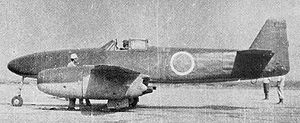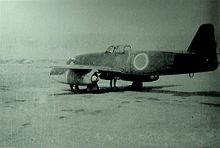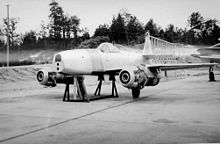Nakajima Kikka Video - Picture

|
|
Nakajima Kikka
Kikka

Role: Interceptor
Ground Attack
Anti-ship, including Kamikaze
Manufacturer: Nakajima
First flight: 7 August 1945
Retired: 15 August 1945
Status: Prototype
Primary user: Imperial Japanese Navy
Number built: 2
The Nakajima Kikka (ä¸å³¶ æ©è±, "Orange Blossom") was Japan's first jet-powered aircraft. It was developed late in World War II and the first prototype had only flown once before the end of the conflict. It also called KÅkoku NigÅ Heiki (çå½äºå·å µå¨, "Imperial Weapon No.2").
Design and development
After the Japanese military attaché in Germany witnessed trials of the Messerschmitt Me 262 in 1944, the Imperial Japanese Navy issued a request to Nakajima to develop a similar aircraft to be used as a fast attack bomber. Among the specifications for the design were the requirements that it should be able to be built largely by unskilled labor, and that the wings should be foldable. This latter feature was to enable the aircraft to be hidden in caves and tunnels around Japan as the Navy began to prepare for the defense of the home islands. Nakajima designers Kazuo Ohno and Kenichi Matsumura laid out an aircraft that bore a strong but superficial resemblance to the Me 262.
The Kikka was designed in preliminary form to use the Tsu-11, a very crude thermojet style of jet engine that was little more than a ducted fan with an afterburner. Subsequent designs were planned around the Ne-10 (TR-10) centrifugal-flow turbojet, and the Ne-12, which added a four-stage axial compressor to the front of the Ne-10. Tests of this powerplant soon revealed that it would not produce anywhere near the power required to propel the aircraft, and the project was temporarily stalled. It was then decided to produce a new axial flow turbojet based on the German BMW 003.
Development of the engine was troublesome, based on little more than photographs and a cut-away drawing; but a suitable unit, the Ishikawajima Ne-20, was finally built. By summer 1945, the Kikka project was making progress once again and at this stage, reflecting the deteriorating war situation, it is possible that the Navy considered employing the Kikka as a kamikaze weapon although the prospect was questionable due to the high cost and complexity associated with contemporary turbojet engines. As well, other more economical projects meant specifically for the role such as the simple Nakajima TÅka (designed to absorb Japanese stock of obsolete engines), the pulsejet-powered Kawanishi Baika, and the infamous Yokosuka Ohka, were either underway or already in mass production.
Compared to the Me 262, the Kikka airframe was noticeably smaller and more conventional in design, with straight (rather than swept) wings and tail surfaces. The triangular fuselage cross section characteristic of the German design was less pronounced, due to smaller fuel tanks. The main landing gear of the Kikka were taken from the A6M Zero and the nose wheel from the tail of a Yokosuka P1Y bomber.
Operational history

Picture - The Nakajima Kikka, equipped with RATO rockets for lift off.
The first prototype commenced ground tests at the Nakajima factory on 30 June 1945. The following month it was dismantled and delivered to Kisarazu Naval Airfield where it was re-assembled and prepared for flight testing. The first flight took place on 7 August 1945, with Lieutenant Commander Susumu Takaoka at the controls. The aircraft performed well during a 20-minute test flight, with the only concern being the length of the takeoff run. For the second test flight, four days later, rocket assisted take off (RATO) units were fitted to the aircraft. Because their alignment had been miscalculated, however, the pilot mistakenly believed that they had not fired and thus shut off the main engines to abort takeoff. As a result the aircraft did not take off at all and was damaged when it ran off the end of the runway. Before it could be repaired Japan had surrendered and the war was over.
At this point, the second prototype was close to completion, and between 18 and 25 more airframes were under construction. One of these was a two-seat trainer. Other follow-on versions proposed had included a reconnaissance aircraft, and a fighter armed with two 30 mm Type 5 cannons with 50 rounds per gun. These were expected to be powered by more advanced developments of the Ne-20, known as Ne-20-Kai or Ne-120, which were planned to have approximately 20% to 30% better thrust than the Ne-20.
Postwar

Picture - A Kikka stationed at the Patuxent River Naval Air Base, Maryland, 1946
After the war, a Kikka was taken to the United States, for analysis, to the Patuxent River Naval Air Base, Maryland. It is now housed in the National Air and Space Museum. This aircraft is very incomplete and is believed to have been patched together from a variety of semi-completed airframes.
Two Ne-20 jet engines had been taken to the US and sent for analysis to the Chrysler Corporation in 1946. This was only revealed in 2005 by W.I. Chapman, who was in charge of the project at the time. A working engine was assembled with the parts of the two Ne-20s, and extensively tested for 11 hours and 46 minutes. A report was issued on 7 April 1947, titled "Japanese NE-20 turbo jet engine. Construction and performance". The document is now on display at the Tokyo National Science Museum.
Variants
Nakajima Aircraft Company developed some variants of the aircraft:
There was also a modified version of the design to be launched from a 200 m long catapult, the "Nakajima Kikka-kai Prototype Turbojet Special Attacker". This differed in having a projected total weight of 4,080 kg and a maximum speed of 687 km/h at 6,000 m.
Operators
Japan
Imperial Japanese Navy (Planned)
Specifications

Picture - Cover page of the Chrysler Corporation 1947 report on the Japanese WWII jet engine Ne-20, titled "Japanese NE-20 turbo jet engine. Construction and performance".
Crew: 1
Length: 8.13 m (26 ft 8 in)
Wingspan: 10.00 m (32 ft 10 in)
Height: 2.95 m (9' 9")
Wing area: 13.2 m² (142ft²)
Empty weight: 2,300 kg (5,071 lb)
Loaded weight: 3,507 kg (7,716 lb)
Max takeoff weight: 4,088 kg (8,995 lb)
Powerplant: 2x Ne-20 turbojets, 4.66 kN (475 kgf) each

Picture - Ne-20 engine taken from the second Kikka prototype on display at the Steven F. Udvar-Hazy Center in Chantilly, Virginia.
General characteristics
Performance
Maximum speed: 695 km/h (433 mph)
Range: 937 km (586 mi)
Service ceiling: 12,303 m (39,370 ft)
Rate of climb: 387 m/min (1,237 ft/min)
Armament
Guns: 4 x 20 mm Ho-5 cannon
Bombs: 1 x 250 kg (551 lb), 500 kg (1,102 lb), or 1,000 kg (2,205 lb) bombs
Related development
Nakajima Ki-201
Comparable aircraft
Bell P-59 Airacomet
Gloster E.28/39
Gloster Meteor
Heinkel He 280
Messerschmitt Me 262
Sukhoi Su-9
Bibliography
Famous Aircraft of the World no.76: Japanese Army Experimental Fighters (1). Tokyo: Bunrin-Do, August 1976.
Francillon, René J. Japanese Aircraft of the Pacific War. London: Putnam & Company Ltd., 1979, First edition 1970. ISBN 0-370-30251-6.
Ishizawa, Kazuhiko. KIKKA: The Technological Verification of the First Japanese Jet Engine Ne 20. Tokyo: Miki Press, 2006. ISBN 4-89522-468-6.
Nakajima Kikka Pictures
Living Warbirds: The best warbirds DVD series.
Source: WikiPedia